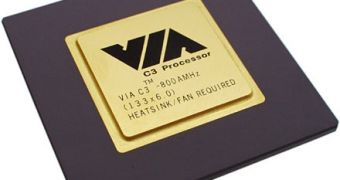VIA has been manufacturing low-energy microprocessors for quite a while now, but its designs would hardly pose any threat for both Intel and AMD. Things are about to change, however, as the latest VIA creation is more than a chip to be used in toasters and microwave ovens.
VIA plans to announce its Isaiah processor later this month. The Isaiah is VIA's flagship product and could score a great market share on the UMPC / MID markets. Isaiah/CN is the manufacturer's first high-performance x86processor, shaped with a modern architecture and increased computing power.
According to the company, it will pitch its upcoming processor at the mainstream PC market, especially at the ultra-mobile notebook computers. In terms of performance and processing power, Isaiah will directly compete with Intel's Atom chip, but Via has a tremendous advantage, as it has been developing energy-efficient chips since it was born.
Richard Brown, VIA's vice president of corporate marketing, said that the Isaiah would put the company into the mainstream market for the first time. Isaiah will take up to 3.5 watts of power while working at full load, while Intel's Atom will draw between 0.6 and 2.5 watts of power. However, VIA's chip has a more complex architecture, able to execute x86 instructions in an out-of-order manner. The chip has a superscalar architecture that allows it to execute three full x86 instructions per clock.
Independent benchmarks have already proven that Isaiah beats the Atom CPU in terms of performance, although only the ALU and FPU tests have been published.
"We're in full agreement with the optimized PC concept", Brown said. An idea put forward by Nvidia's CEO Jen-Hsun Huang postulates that a consumer will get better PC price-performance by adding a $50 graphics card rather than a two or three hundred dollar quad-core processor. "You can have a processor like Isaiah matched with a better graphics card", Brown said. "There's opportunity in both desktops and notebooks", he concluded.

 14 DAY TRIAL //
14 DAY TRIAL //